It’s no surprise that roses are one of the most popular flowers to grow in home gardens. With large and showy blooms, roses are commonly kept as centerpieces in ornamental beds, and fragrant varieties can be the stars of scent gardens. But if you’ve ever wondered what plants grow best with roses, this guide on companion planting can help!
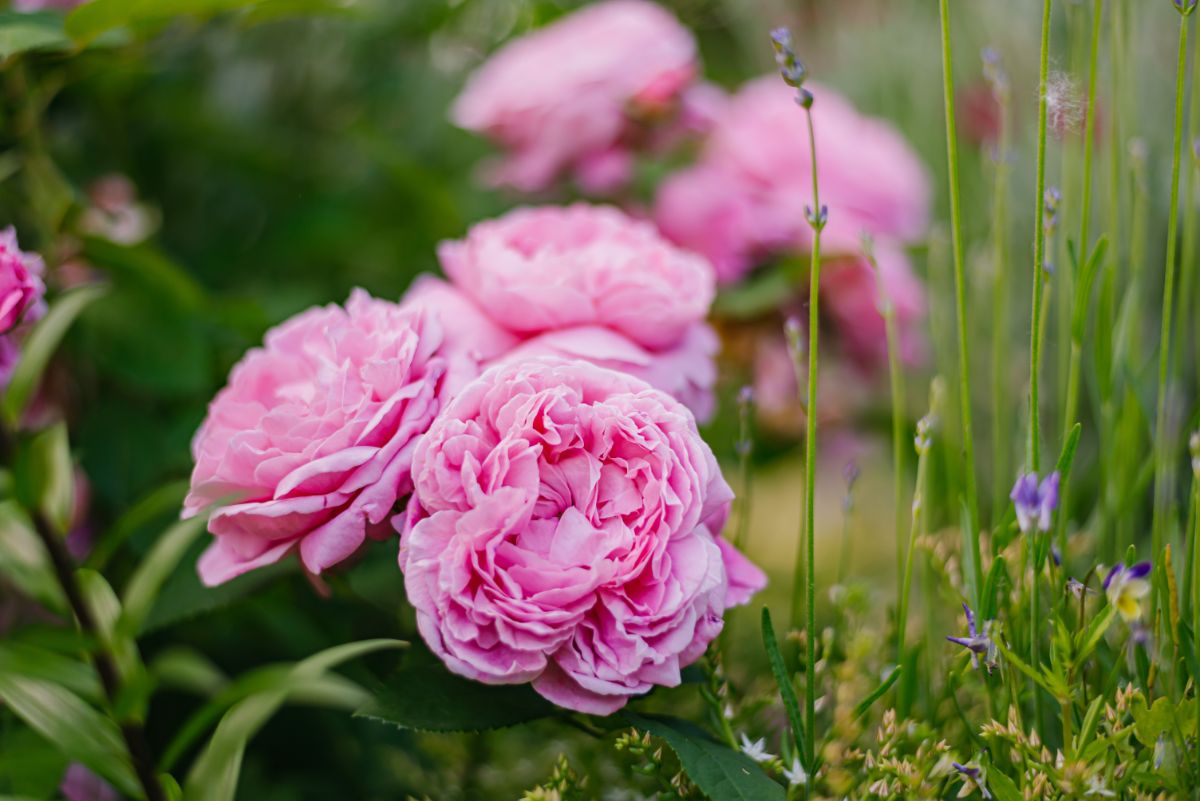
In the list below, you’ll find some of the top plants to keep beside your rose bushes. Some of the plants on this list are perfect for repelling pests that may feed on your roses. Other selections just pair beautifully with roses and have similar growing requirements.
No matter what varieties of roses you keep, you’ll find exceptional rose companions right here!
Jump to:
- 21 best companion plants for roses
- 1. Alliums (Allium spp.)
- 2. Lavender (Lavandula spp.)
- 3. Scented geraniums (Pelargonium graveolens)
- 4. Feverfew (Tanacetum parthenium)
- 5. Catmint (Nepeta racemosa)
- 6. Rue (Ruta graveolens)
- 7. Yarrow (Achillea millefolium)
- 8. Parsley (Petroselinum crispum)
- 9. Anise hyssop (Agastache foeniculum)
- 10. Foxglove (Digitalis purpurea)
- 11. Oregano (Origanum vulgare)
- 12. Dianthus (Dianthus spp.)
- 13. Russian sage (Perovskia atriplicifolia)
- 14. Sage (Salvia officinalis)
- 15. Marigolds (Tagetes spp.)
- 16. Cosmos (Cosmos spp.)
- 17. Thyme (Thymus vulgaris)
- 18. Baby’s breath (Gypsophila spp.)
- 19. Salvia (Salvia spp.)
- 20. Larkspur (Delphinium spp.)
- 21. Germander (Teucrium spp.)
- Summary
21 best companion plants for roses
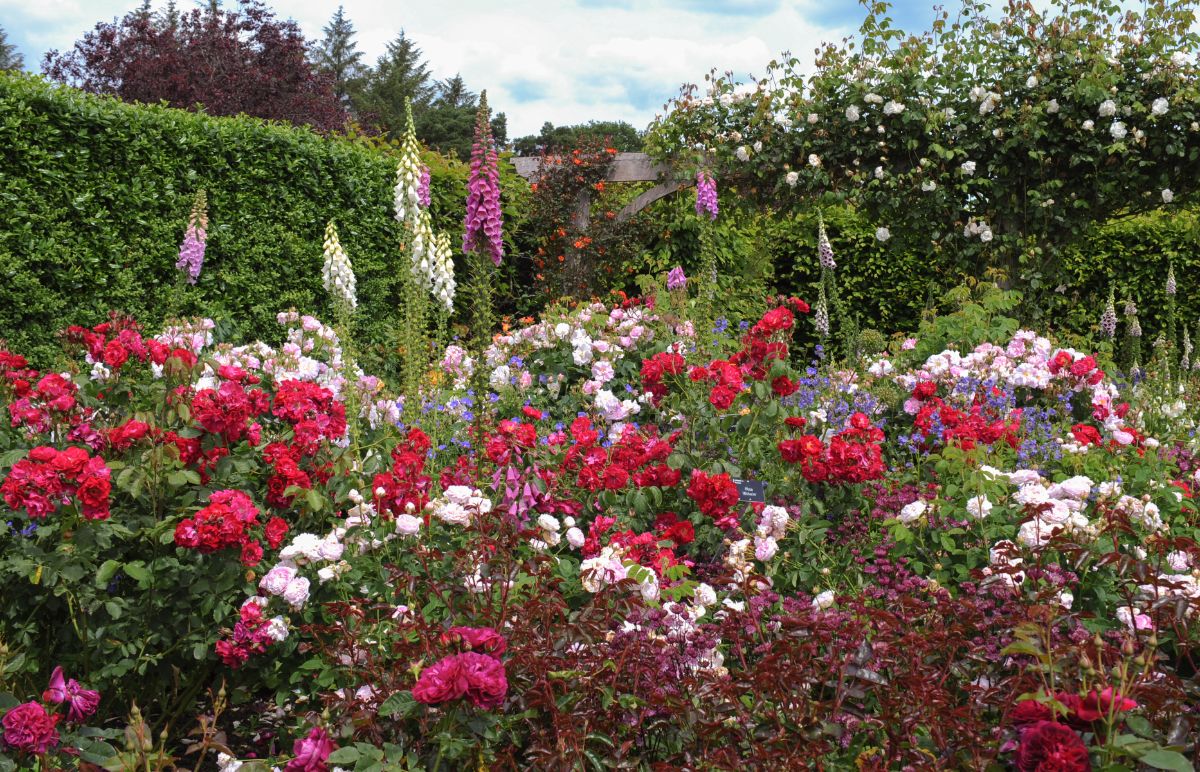
Certain plants offer very specific benefits to roses when grown as companions. Some strongly scented herbs are ideal for natural pest control, while other flowers may produce complementary blooms or flowers earlier or later in the season than roses do. Growing these plants together can create a healthier garden with continuous blooms and more vigorous plants.
1. Alliums (Allium spp.)

| Plant name: | Alliums |
| Lighting requirements: | Full sun to part shade |
| Watering requirements: | Moderate to low |
| Growing zone: | Zones 3 to 9 |
| Special features: | Natural pest control; Some edible species; Pollinator favorite |
Members of the allium family are well-known for their natural ability to repel pests. So, it should come as no surprise that these plants make ideal companion plants for roses!
If you don’t want to plant garlic, chives, and onions near your roses for aesthetic reasons, ornamental alliums can make a fun plant companion to grow beside your rose bushes. While rose blooms are classically shaped, alliums have curious, ball-shaped flowers that will provide lots of interesting contrast.
In addition to repelling aphids, alliums can protect your rose bushes from black spot and mildew issues. There is also some evidence that growing alliums near roses may enhance the fragrance of your flowers.
2. Lavender (Lavandula spp.)
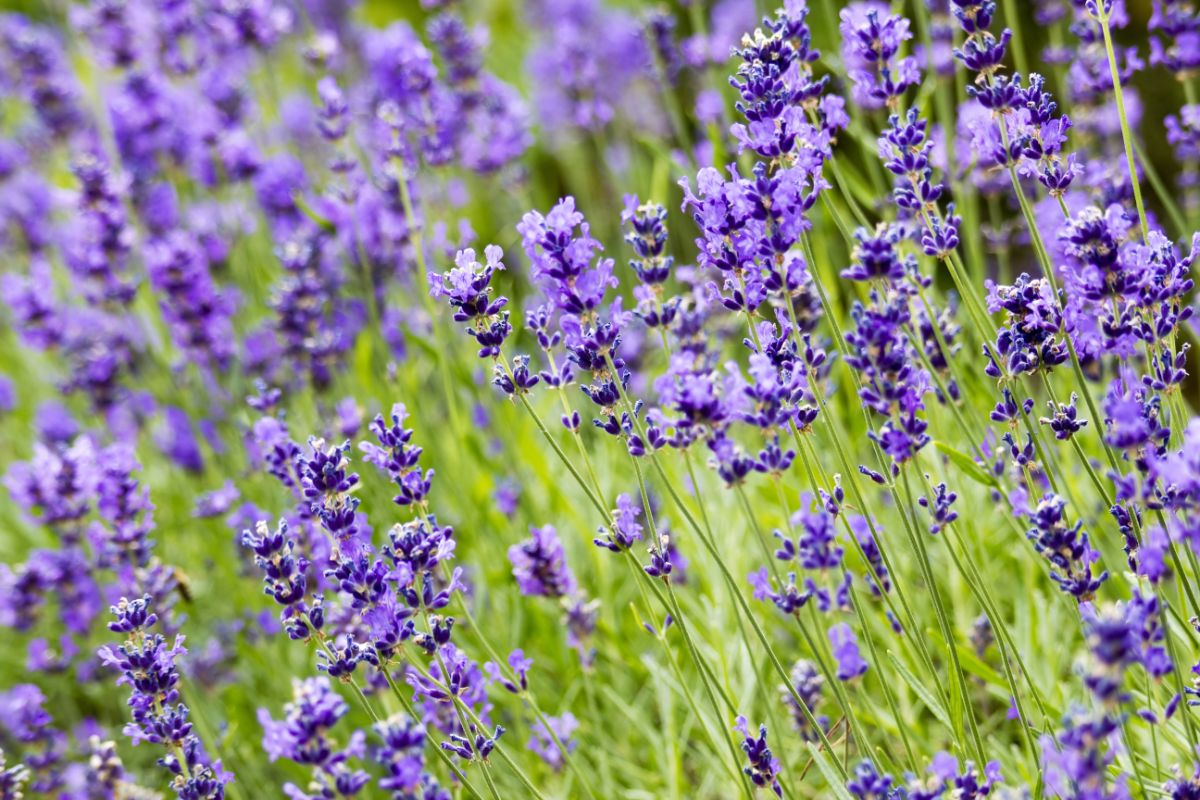
| Plant name: | Lavender |
| Lighting requirements: | Full sun |
| Watering requirements: | Moderate to low |
| Growing zone: | Zones 5 to 9, depending on variety |
| Special features: | Natural pest control; Edible; Strong fragrance; Pollinator favorite |
A classic companion plant pair, growing lavender and roses together, makes sense in just about any garden design. These two plants have contrasting forms, which complement each other. Additionally, lavender and roses both exude rich fragrances that can be the highlight of ornamental or scent gardens.
But roses and lavender aren’t just good companions for superficial reasons. These two plants also have similar growing requirements, and certain rose cultivars, like floribunda roses, crave the same well-draining soil types that lavender needs. What’s more, lavender repels rabbits, which may otherwise feast on your rose bushes!
3. Scented geraniums (Pelargonium graveolens)
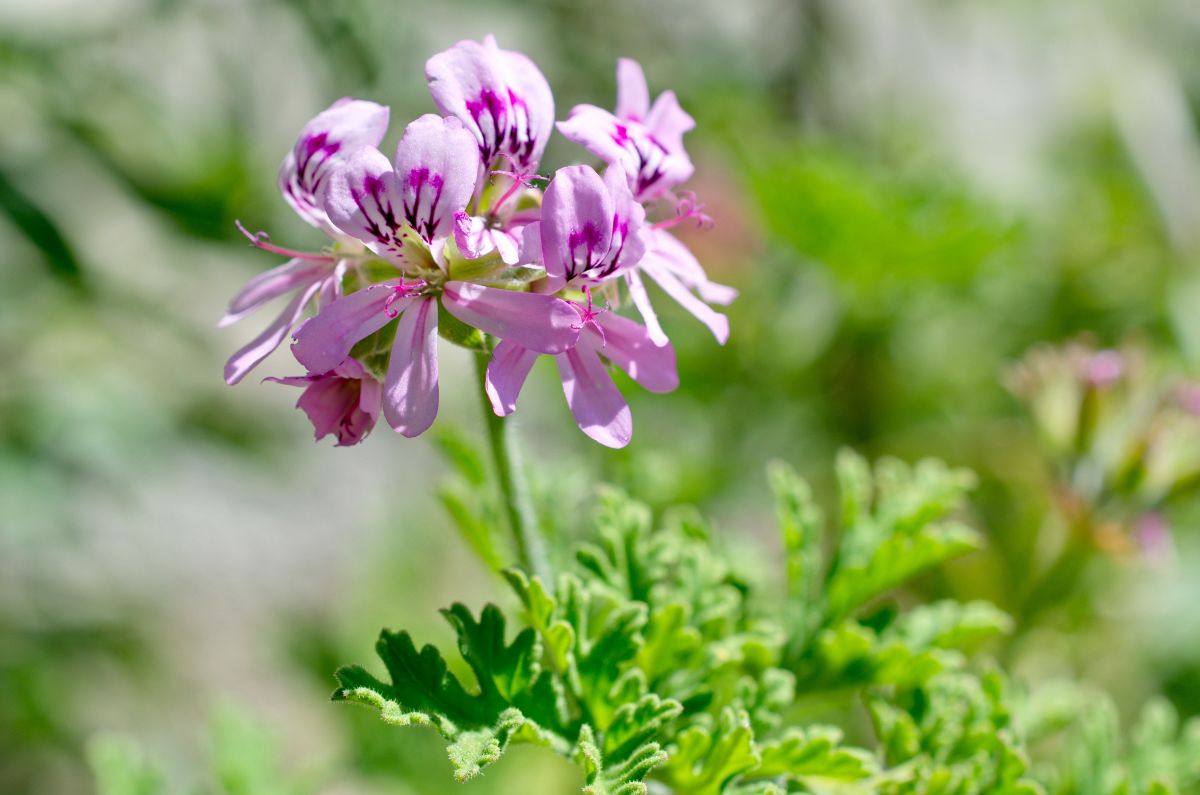
| Plant name: | Scented geraniums |
| Lighting requirements: | Full sun |
| Watering requirements: | Moderate |
| Growing zone: | Zones 10 to 11, grown as annuals in cooler climates |
| Special features: | Natural pest control; Strong fragrance |
Roses can often be targeted by Japanese beetles that will feed on rose foliage, leaving it riddled with lacey holes. But sowing scented geraniums nearby can prevent these pests and aphids too! In fact, studies have found that Japanese beetles will often feed on geranium leaves and die shortly thereafter, leaving your roses unharmed.
In addition to their ability to control pests, geraniums are attractive plants, and they can fill in empty garden space around your rose stems. Roses often have bare branches near the ground, but lower-growing geraniums can conceal leggy stems and add color to your garden beds.
4. Feverfew (Tanacetum parthenium)
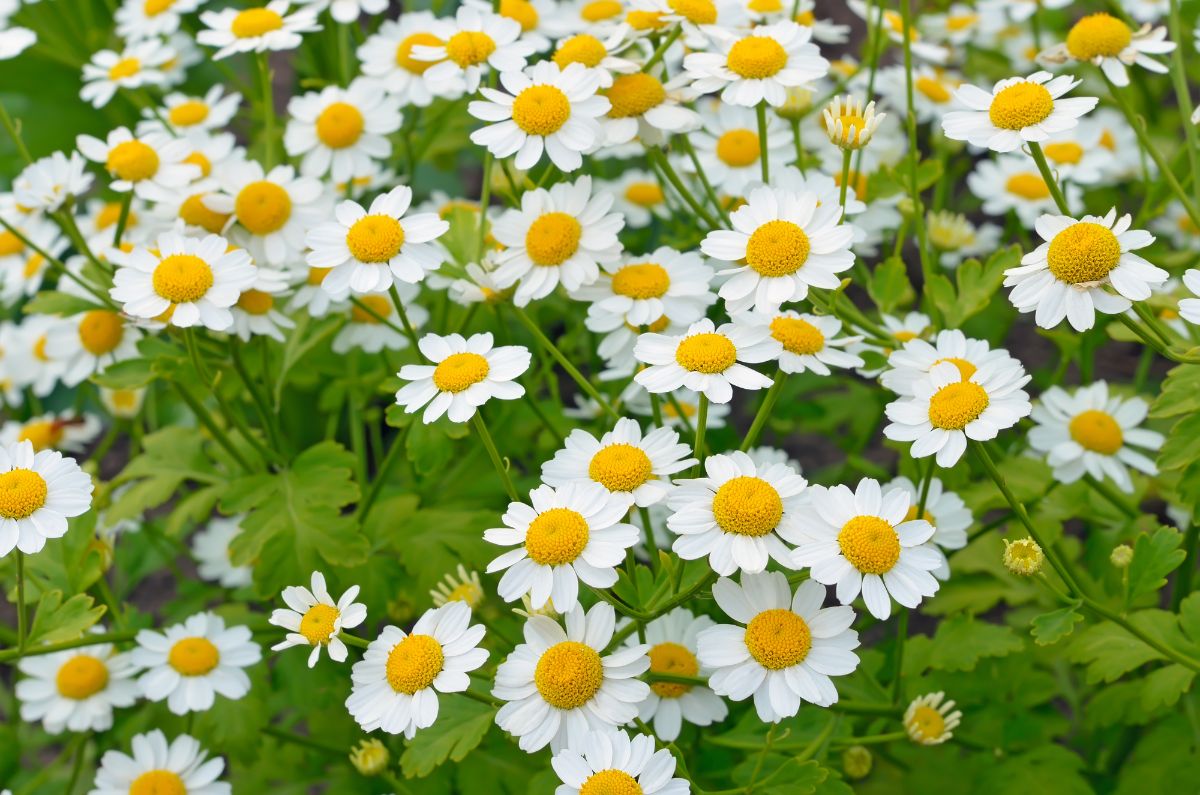
| Plant name: | Feverfew |
| Lighting requirements: | Full sun to part shade |
| Watering requirements: | High to moderate |
| Growing zone: | Zones 5 to 8 |
| Special features: | Natural pest control |
Feverfew was once a staple in medicinal gardens, but it is mostly kept as an ornamental today. With small, daisy-like flowers in white and gold, feverfew is a charming little plant that is sure to put a smile on your face when it comes into bloom. But feverfew packs a punch in the garden too!
Feverfew can repel an assortment of garden pests, including moths, mosquitoes, and mites, and it is often used in pest-repellent sprays. Planting feverfew near your roses will keep pests at bay. Feverfew can also add color near the base of your rose plants, and it attracts pollinators as well.
5. Catmint (Nepeta racemosa)
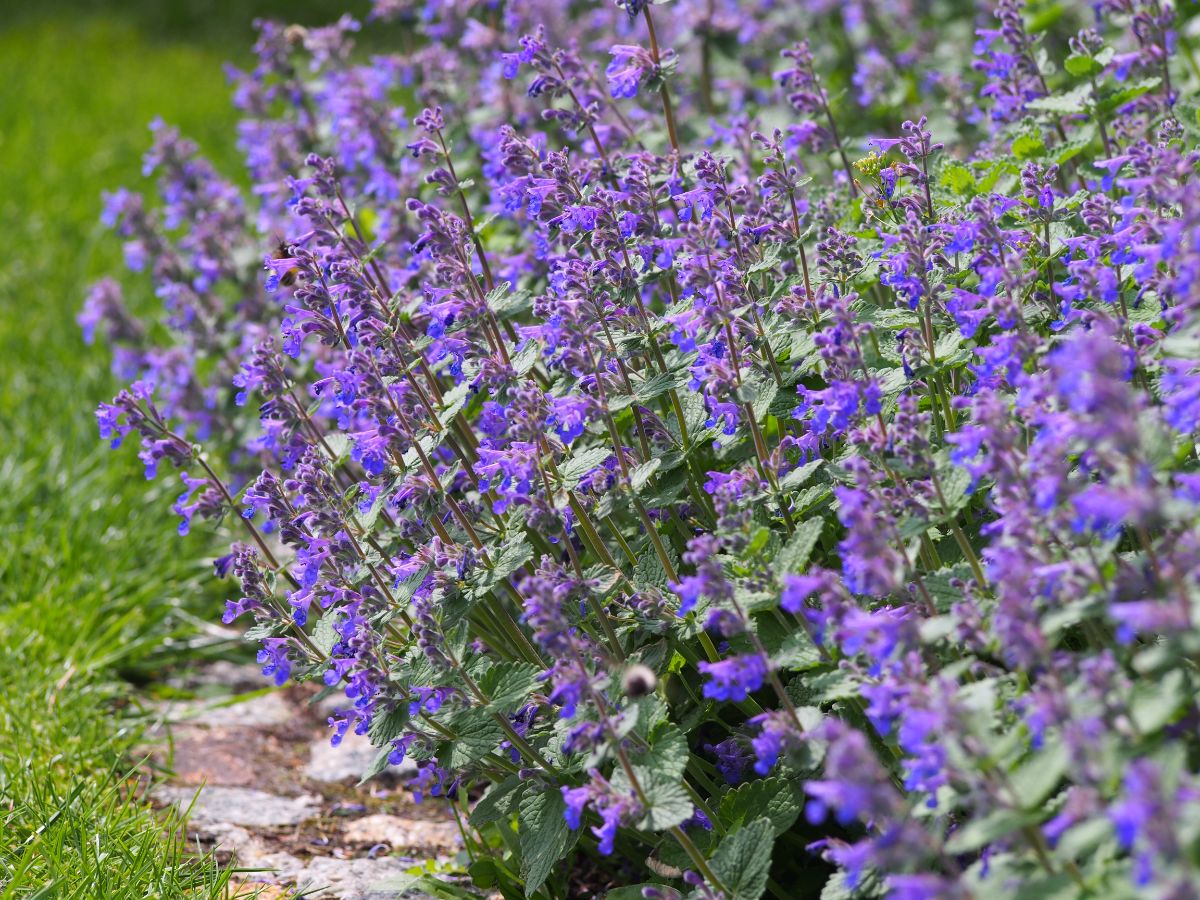
| Plant name: | Catmint |
| Lighting requirements: | Full sun to part shade |
| Watering requirements: | Moderate to low |
| Growing zone: | Zones 3 to 8 |
| Special features: | Natural pest control; Pollinator favorite |
There’s nothing like growing catmint near your roses to create a playful contrast of color and texture. Catmint’s silvery foliage and purple flowers make a stunning complement to pale pink and white roses. Additionally, since catmint grows lower to the ground, it can easily conceal bare rose stems and complete your garden design.
Although they have similar names, catmint is not the same plant as catnip. Catmint doesn’t attract cats quite as much as catnip does, and it has a tidier appearance in the garden. Catnip, on the other hand, can look a bit unruly if left unchecked.
6. Rue (Ruta graveolens)
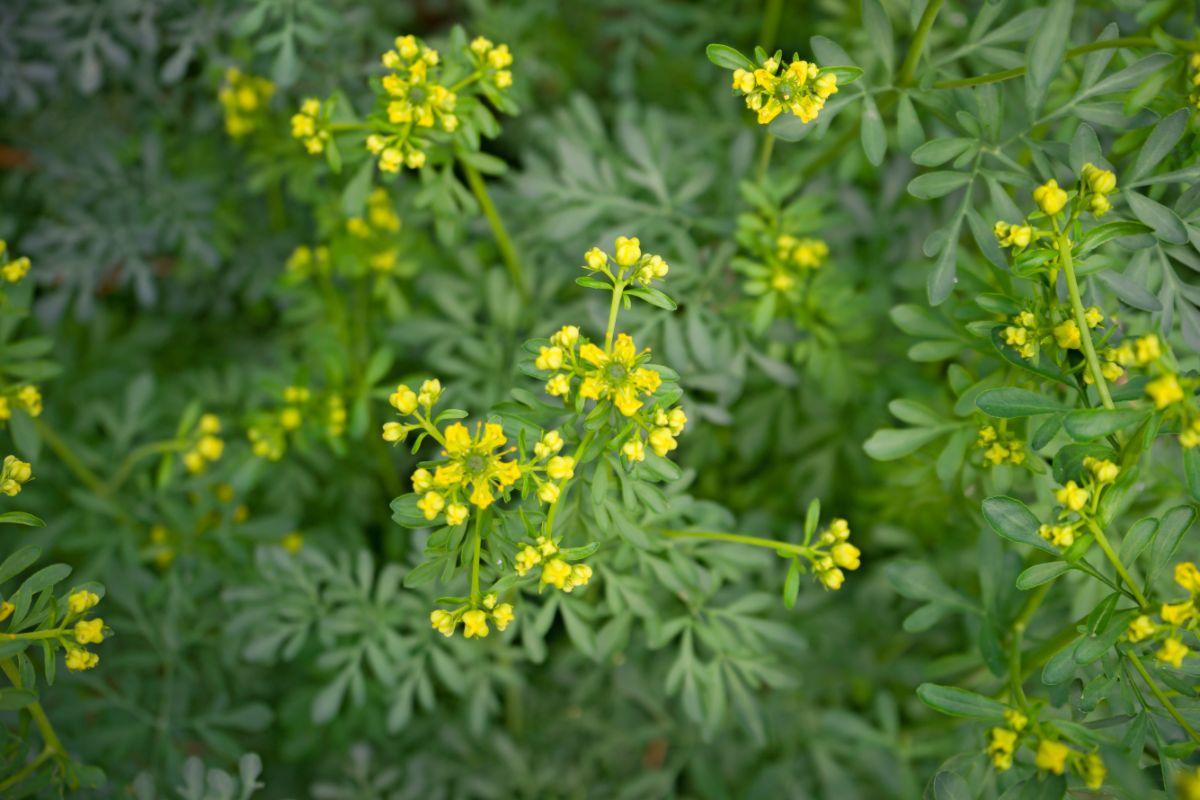
| Plant name: | Rue |
| Lighting requirements: | Full sun to part shade |
| Watering requirements: | Moderate to low |
| Growing zone: | Zones 4 to 9 |
| Special features: | Natural pest control; Pollinator favorite |
Another traditional medicinal plant, rue, is pretty ornamental, and bees and other pollinators love this plant too! However, not all insects are a fan of rue’s strong scent.
Rue is known to repulse Japanese beetles, as well as some other pest insects. Planting rue near your roses can keep your rose bushes blemish-free, and the rue’s silvery foliage can add nuance and color to your rose garden. Not to mention, roses and rue have similar growing requirements!
7. Yarrow (Achillea millefolium)
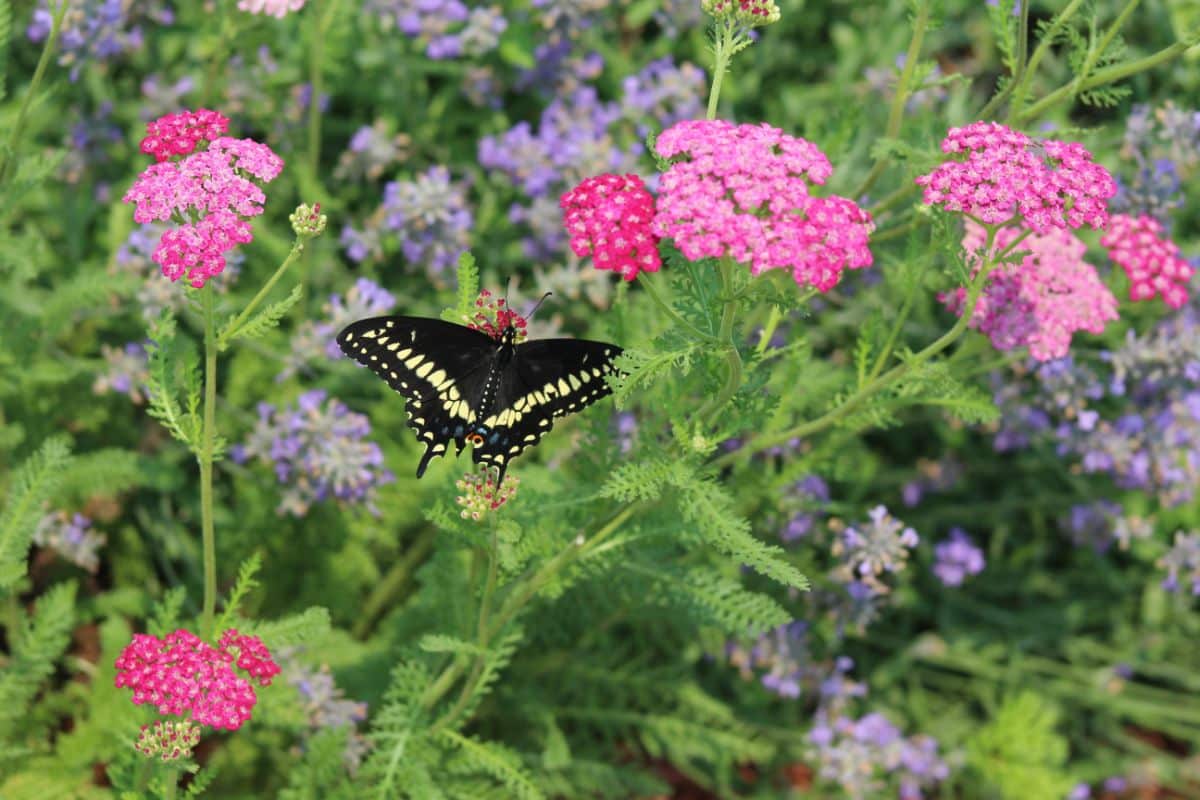
| Plant name: | Yarrow |
| Lighting requirements: | Full sun to part shade |
| Watering requirements: | Moderate to low |
| Growing zone: | Zones 3 to 9 |
| Special features: | Pollinator favorite; Drought resistant; Great for cut flowers |
Yarrow is a hardy plant that doesn’t need much in the garden. Capable of thriving in a range of soils, yarrow is drought-tolerant and adaptable. It also is perfect for attracting beneficial insects, which can feed on rose pests.
A top pollinator plant, yarrow features wide, flat blooms that are easy for bees and butterflies to perch on when feeding. Yarrow flowers come in white, pink, yellow, and orange and look like sturdier versions of Queen’s Anne’s lace. Yarrow also has fine, feathery foliage that moves beautifully with the wind, and flowers dry well for preserved displays too!
8. Parsley (Petroselinum crispum)
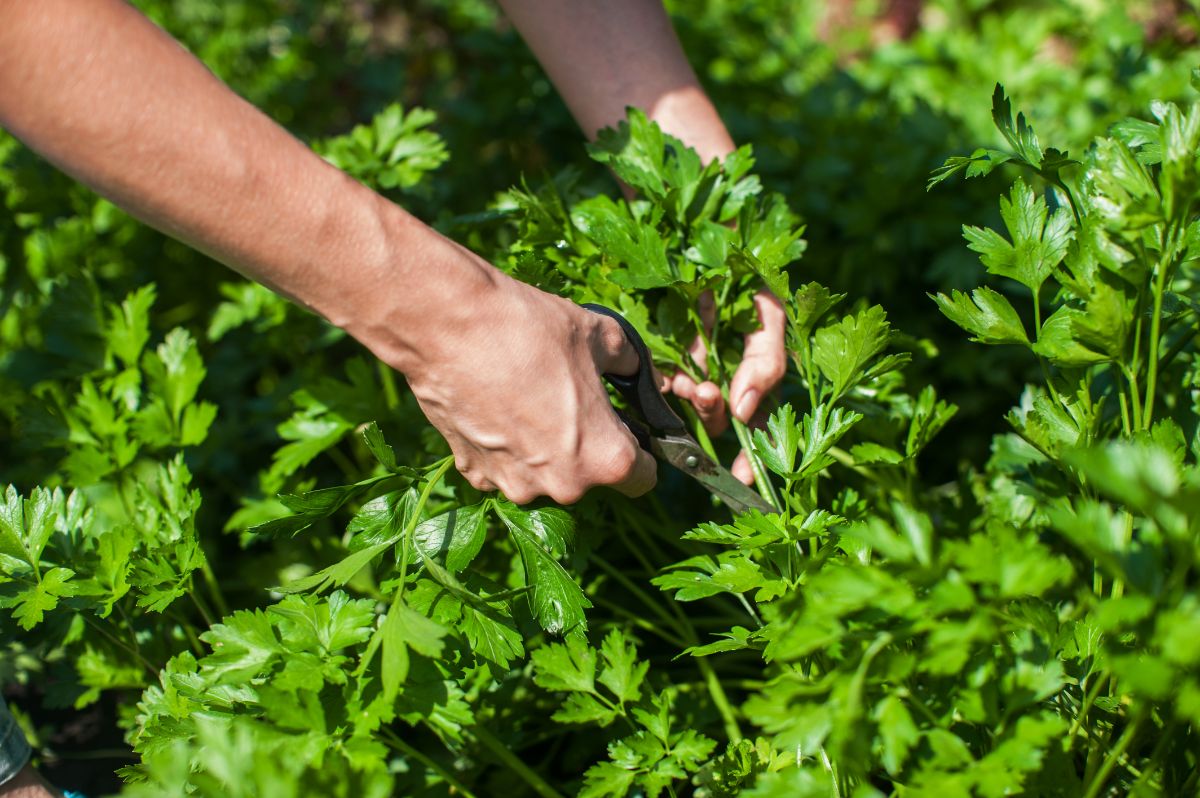
| Plant name: | Parsley |
| Lighting requirements: | Full sun to part shade |
| Watering requirements: | Moderate |
| Growing zone: | Zones 4 to 9 |
| Special features: | Edible; Natural pest control |
Parsley and roses aren’t an obvious plant pair, but there are a lot of reasons why you may want to grow these plants together. Parsley attracts predatory wasps that will feed on aphids, and other rose pests. Additionally, parsley’s scent can repel rose beetles.
Growing parsley near your roses is said to improve the fragrance of your flowers. But if you don’t want to plant parsley in your ornamental beds, this small plant can be easily grown in containers placed throughout your garden. As a biennial, parsley will need to be replanted every two years, although this plant self-seeds if you allow it to go to flower.
9. Anise hyssop (Agastache foeniculum)
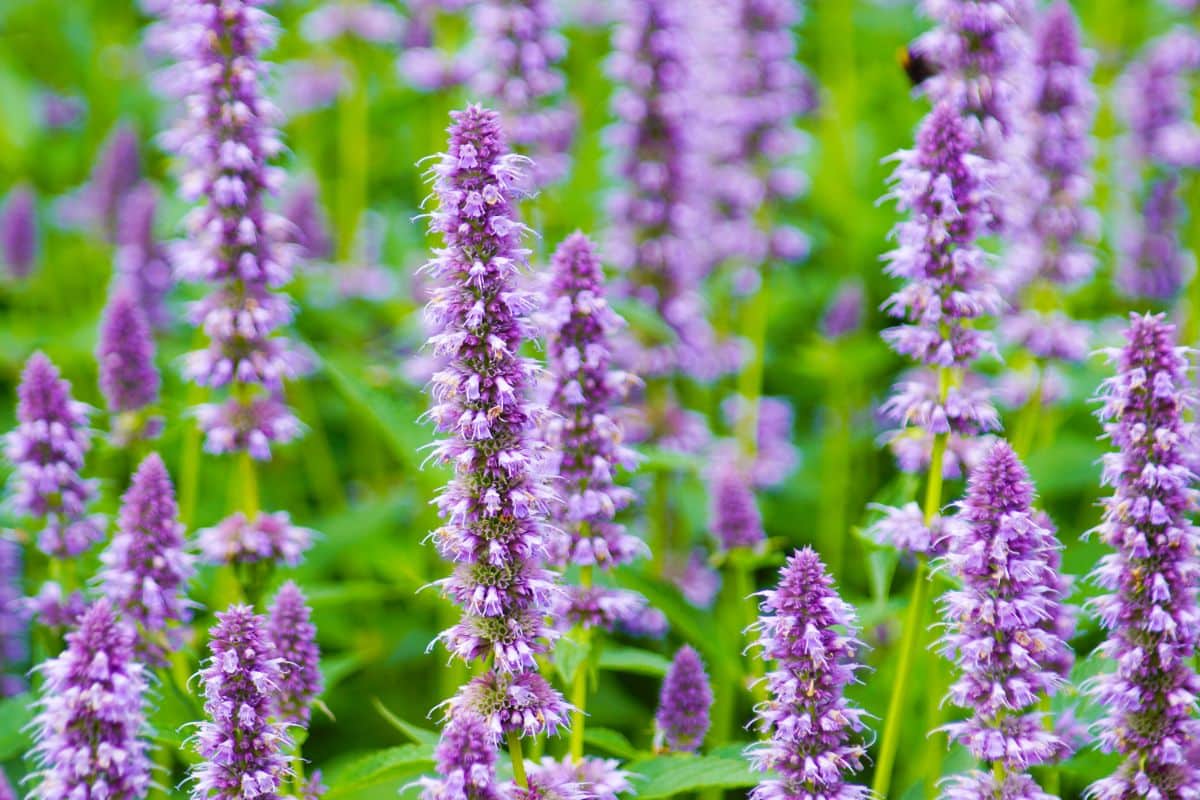
| Plant name: | Anise hyssop |
| Lighting requirements: | Full sun |
| Watering requirements: | Moderate to low |
| Growing zone: | Zones 4 to 8 |
| Special features: | Edible; Pollinator favorite |
Anise hyssop is a popular pollinator plant that is an important food source for bees and butterflies. Tall, columnar flowers bloom from June to early fall and come in purple and blue hues. When grown together, the structural look of anise hyssop accentuates the curves of rose blossoms making for a complex yet endearing planting design.
Also known as licorice mint, anise hyssop flowers are edible and are sometimes used as colorful accents on desserts and salads. The plant itself produces a fine, anise-like aroma that may also repel deer. Even better, anise hyssop is a low-maintenance plant, and it can handle drought with ease.
10. Foxglove (Digitalis purpurea)
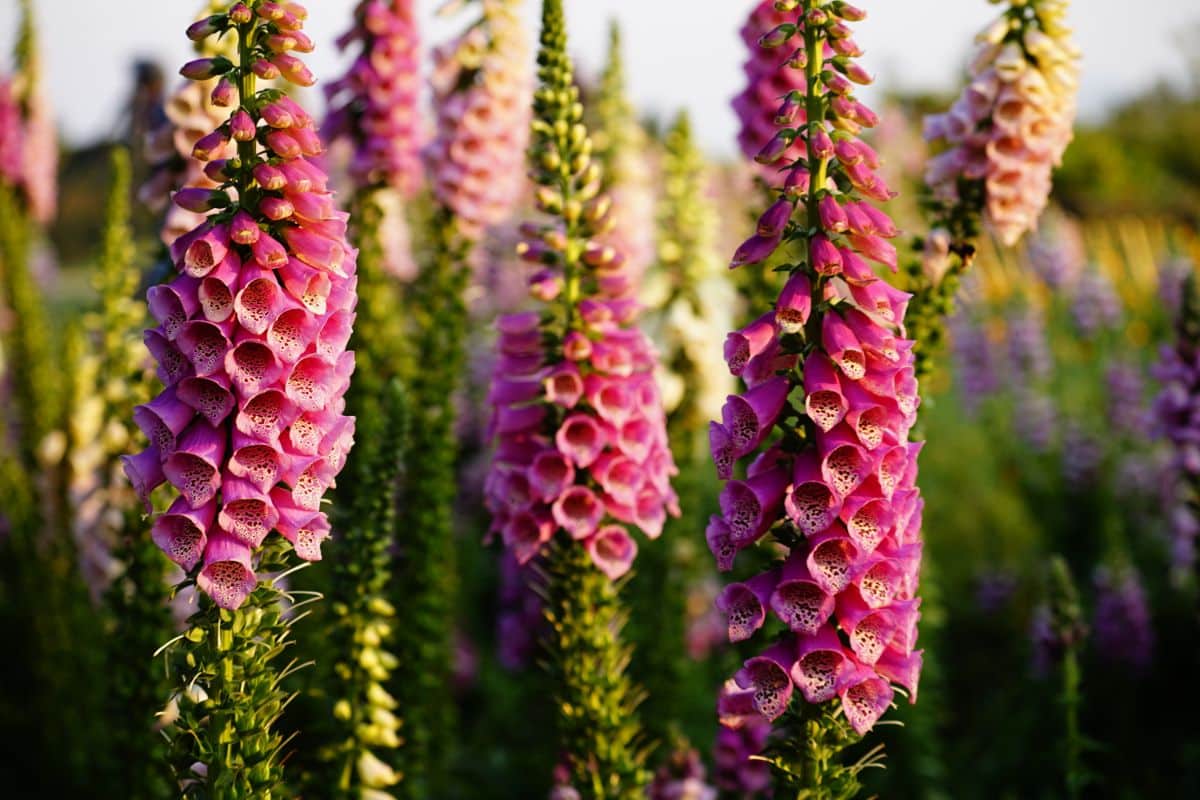
| Plant name: | Foxglove |
| Lighting requirements: | Full sun to part shade |
| Watering requirements: | Moderate |
| Growing zone: | Zones 4 to 9 |
| Special features: | Pollinator favorite |
Like anise hyssop, foxglove flowers have a very different shape and silhouette from roses. Growing these plants near your roses is sure to catch the eye. And, if you love the look of cottage gardens, foxgloves and roses are the top plants to grow!
Foxgloves bloom in early summer and produce their characteristic clusters of tall, bell-shaped flowers. From yellow and white to pink and purple, you can find foxgloves in many different colors to suit your tastes. As biennial plants, foxgloves bloom in their second year if you grow them from seed, but you can get flowers earlier if you purchase nursery starts.
11. Oregano (Origanum vulgare)

| Plant name: | Oregano |
| Lighting requirements: | Full sun |
| Watering requirements: | Moderate to low |
| Growing zone: | Zones 5 to 10 |
| Special features: | Edible; Natural pest control |
Like other strongly scented herbs, oregano may repel pest insects that would otherwise riddle your rose bushes with holes and nasty damage. Plus, oregano is also a delicious herb, and sowing some in your ornamental beds is a wonderful way to fill in space and make the best use of a small garden.
Oregano is a cold hardy plant, and in many climates, oregano will stay green even under the snow. That means you’ll still be able to harvest fresh oregano straight from the garden, even in the middle of winter!
12. Dianthus (Dianthus spp.)
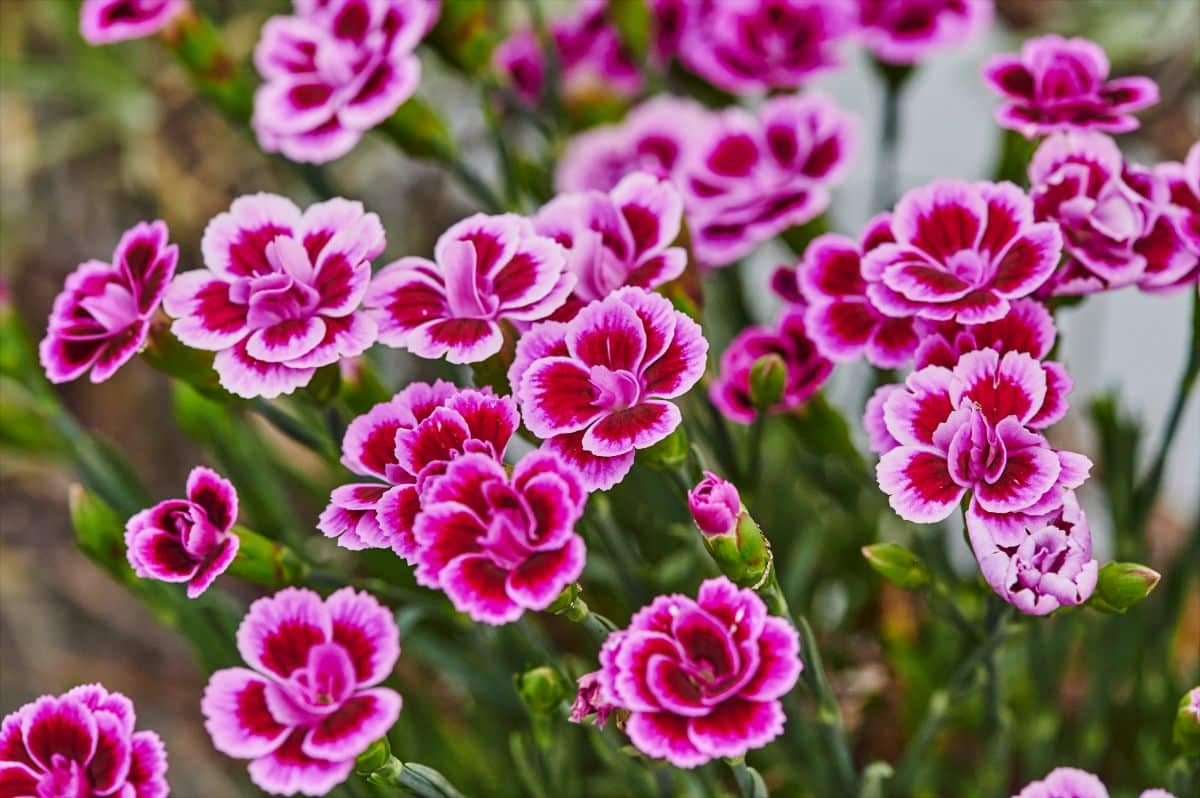
| Plant name: | Dianthus |
| Lighting requirements: | Full sun to part shade |
| Watering requirements: | Moderate |
| Growing zone: | Zones 4 to 8 |
| Special features: | Great for cut flowers |
Dianthus and roses are often arranged together in floral displays and bouquets, but these two plants grow well together too. Dianthus is a smaller plant and can fill in bare spots around the base of your roses. Plus, dianthus usually blooms a bit earlier than roses, and they will fill your garden up with color while you’re waiting for your roses to bud.
Dianthus can be purchased as nursery starts, but for a more economical option, try starting your own plants from seed. Dianthus seeds can be directly sown outdoors or planted inside about 8 weeks before your last frost date. Seedlings can be transplanted outside after all danger of frost has passed, but be sure to harden them off first.
13. Russian sage (Perovskia atriplicifolia)
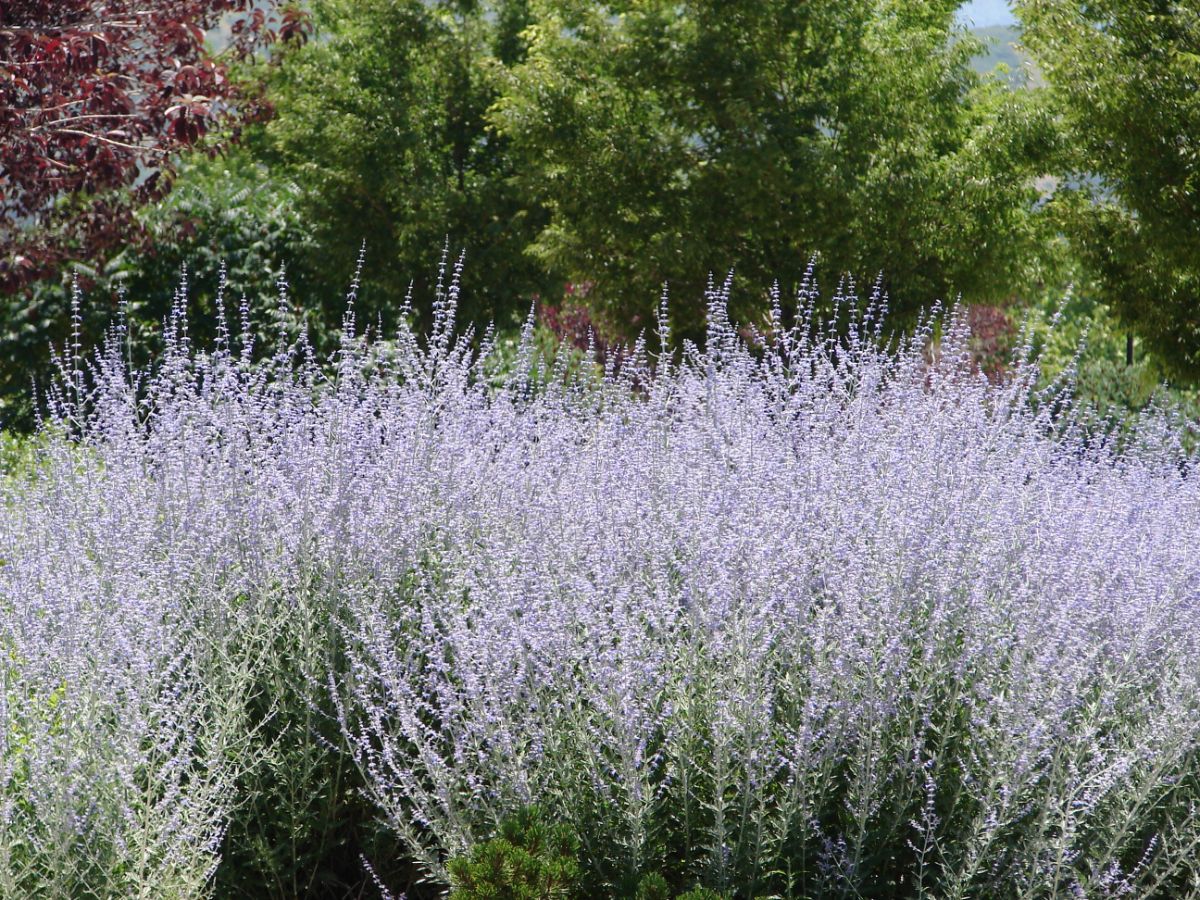
| Plant name: | Russian sage |
| Lighting requirements: | Full sun |
| Watering requirements: | Moderate to low |
| Growing zone: | Zones 4 to 9 |
| Special features: | Pollinator favorite |
Russian sage has a dreamy quality to it, with tall, purple flowers that beautifully complement the plant’s silvery-green foliage. Growing between 3 and 5’ tall, Russian sage makes a splendid backdrop to frame your rose bushes. Just keep in mind that these plants can spread, and it’s important to follow proper spacing guidelines to prevent them from overwhelming your roses.
Another low-maintenance plant, Russian sage doesn’t require a lot of fuss, and it’s drought tolerant once established. Bees and other pollinators also love this plant, and you’ll adore its delicate fragrance too.
14. Sage (Salvia officinalis)
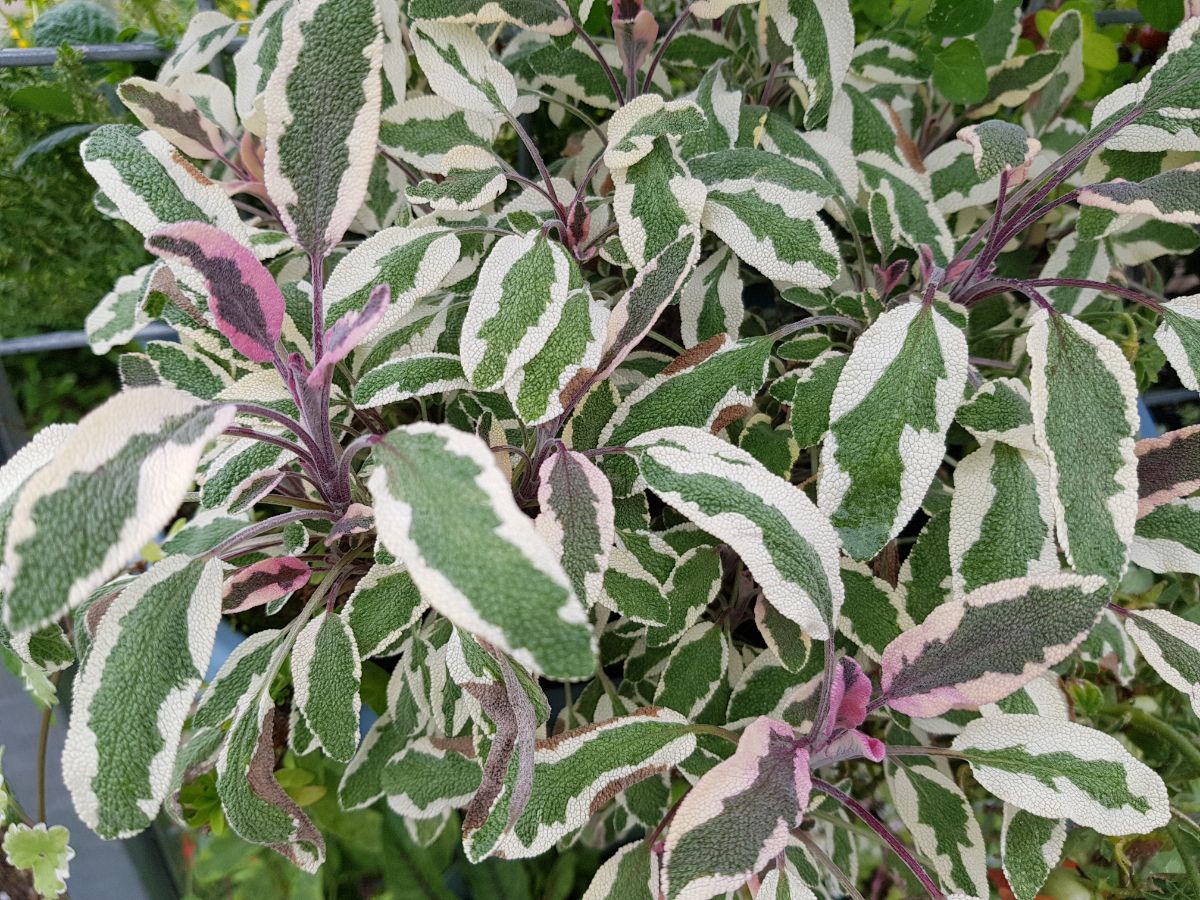
| Plant name: | Sage |
| Lighting requirements: | Full sun |
| Watering requirements: | Moderate to low |
| Growing zone: | Zones 4 to 11 |
| Special features: | Edible; Pollinator favorite |
Despite its name, Russian sage is not a true sage or salvia, but culinary sage is! That same sage you use to flavor soups and roasted dishes actually makes a very attractive ornamental plant, and it has similar growing requirements to roses. Once mature, sage can grow up to 2 ½” tall, and it produces an array of pretty purple flowers that bees can’t resist.
Classic culinary sage has gray-green leaves that are quite pretty, but if you want something different, there are other varieties of sage to choose from. Purple sage and variegated sage have even more colorful leaves, but they contribute the same wonderful flavor to recipes.
15. Marigolds (Tagetes spp.)
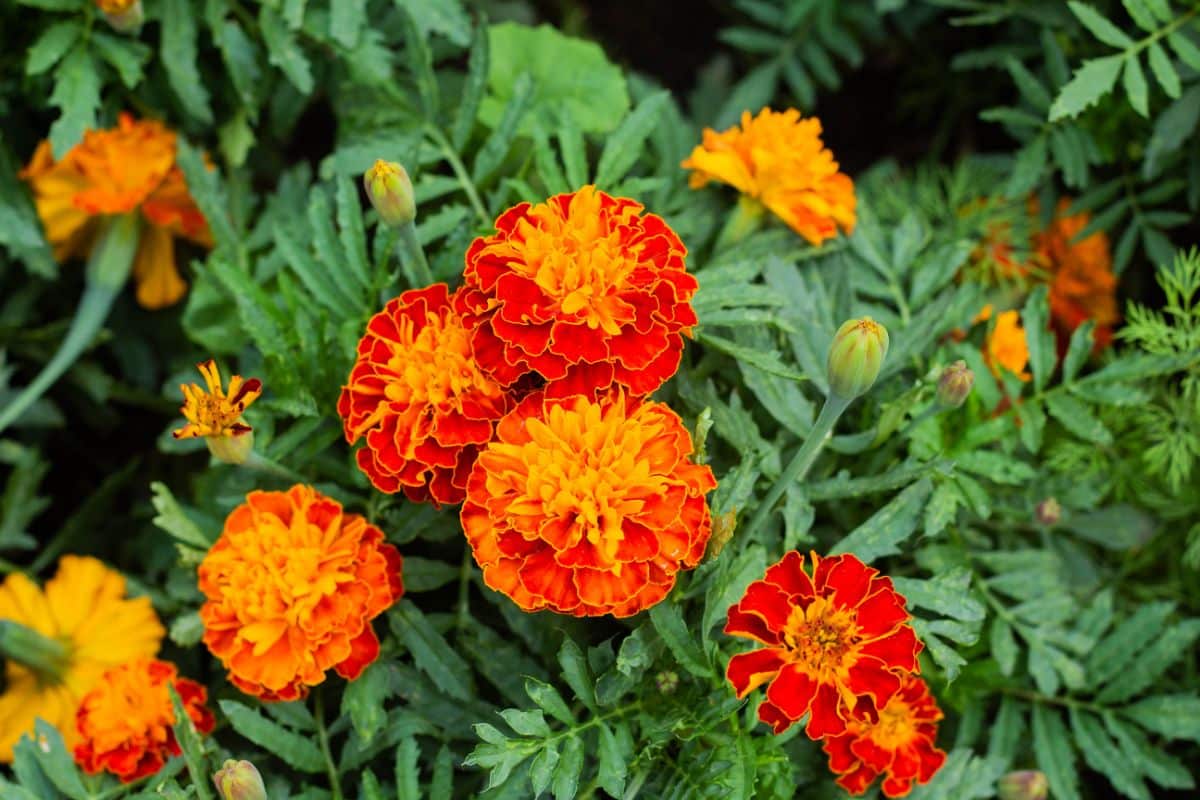
| Plant name: | Marigolds |
| Lighting requirements: | Full sun to part shade |
| Watering requirements: | Moderate |
| Growing zone: | Zones 2 to 11 |
| Special features: | Natural pest control |
Marigolds are often used as companion plants in vegetable gardens due to their pest-repelling abilities, but they work equally well in rose gardens. In addition to keeping pests away, marigolds repulse deer and rabbits, but pollinators love them.
Marigolds have similar growing needs to roses, and if you keep these plants together, you won’t need to increase your gardening chores one bit. You can find marigolds in a variety of sizes, including small dwarf varieties that are perfect for container gardens.
16. Cosmos (Cosmos spp.)
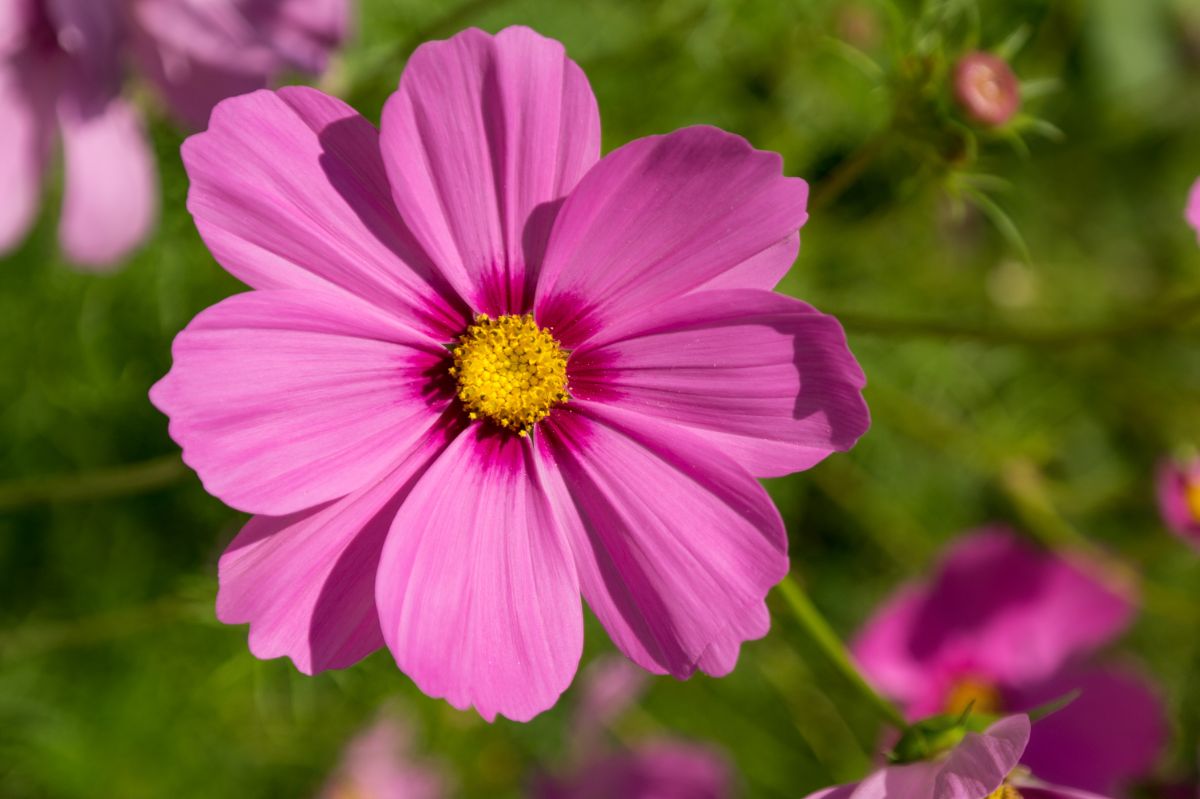
| Plant name: | Cosmos |
| Lighting requirements: | Full sun |
| Watering requirements: | Moderate to low |
| Growing zone: | Zones 2 to 11 |
| Special features: | Great for cut flowers |
Cosmos are dainty, annual flowers that boast delicate petals in white and various shades of pink. These plants also have feathery foliage that gives the plant a light and airy feel. When grown with roses, cosmos flowers complement rose blooms beautifully, and they can be used to fill in bare spots around your roses as well.
Cosmos are annual plants that are generally grown from seed, although you may be able to find pre-started plants at your local nursery. After flowers fade, you can deadhead spent blooms or leave them in place and allow the plant to self-sow the next generation of cosmos. Florists love working with the cosmos, and if you also like making bouquets, these plants are definitely must-haves.
17. Thyme (Thymus vulgaris)
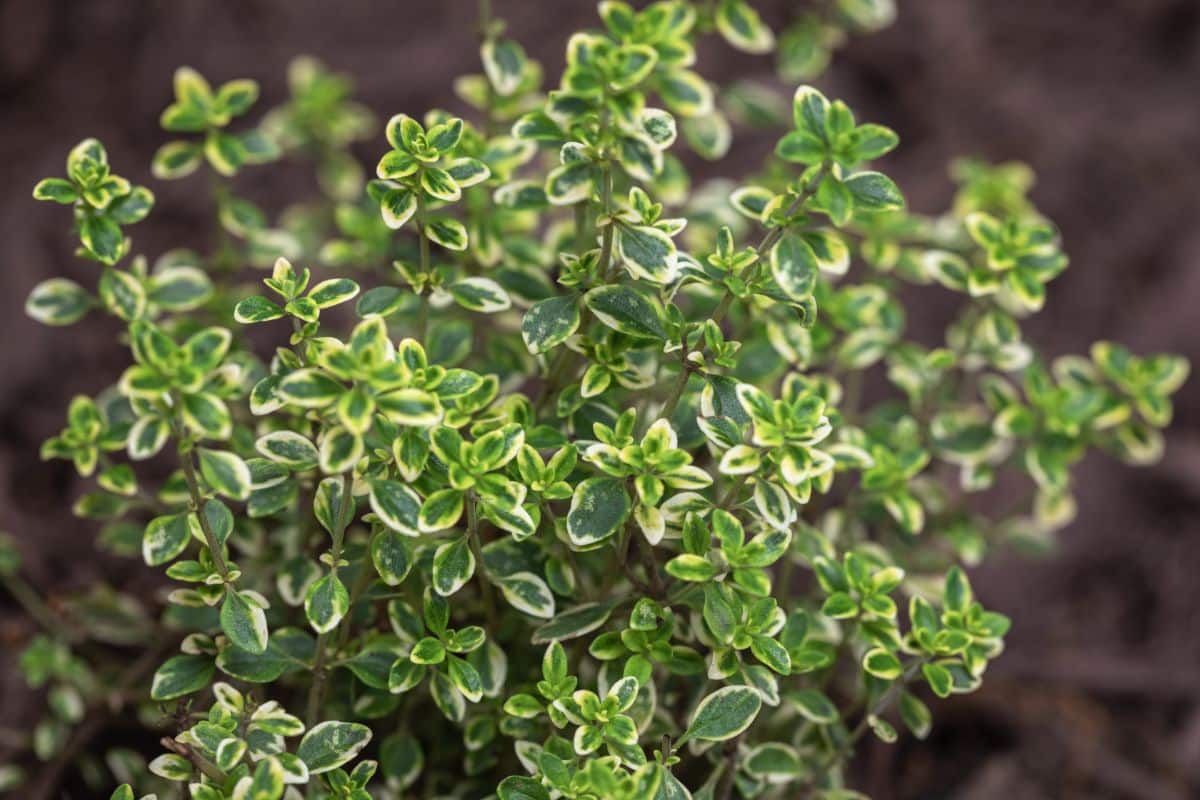
| Plant name: | Thyme |
| Lighting requirements: | Full sun |
| Watering requirements: | Moderate to low |
| Growing zone: | Zones 2 to 10, depending on variety |
| Special features: | Edible; Natural pest control; Weed suppression |
Another fragrant herb, thyme, can be used for natural pest control, and thyme flowers lure in an assortment of beneficial insects that feed on rose pests. Thyme blooms also provide nectar and pollen to pollinators, so if you want to increase pollinator activity in your garden, plant some thyme.
There are many different types of thyme to grow, including colorful, variegated options. Creeping time is another fun pick, which can be used as a low-maintenance ground cover to keep weeds down. A mat of creeping thyme around your roses will look even prettier when it flowers pinkish-purple blooms from summer to early fall.
18. Baby’s breath (Gypsophila spp.)

| Plant name: | Baby’s breath |
| Lighting requirements: | Full sun |
| Watering requirements: | Moderate to low |
| Growing zone: | Zones 4 to 9 |
| Special features: | Great for cut flowers |
If you buy a bouquet of red roses, chances are there’s a sprig or two of baby’s breath included in the bunch. But if you prefer to grow your own flowers for bouquets, you can easily cultivate a baby’s breath at home.
Baby’s breath and roses have similar growing needs, and they can be planted together in the same garden bed. Baby’s breath has low watering needs, and it prefers full sun. When mature, baby’s breath plants can grow up to 3’ tall, and cut flowers also dry exceptionally well for crafting and homemade wreaths.
19. Salvia (Salvia spp.)
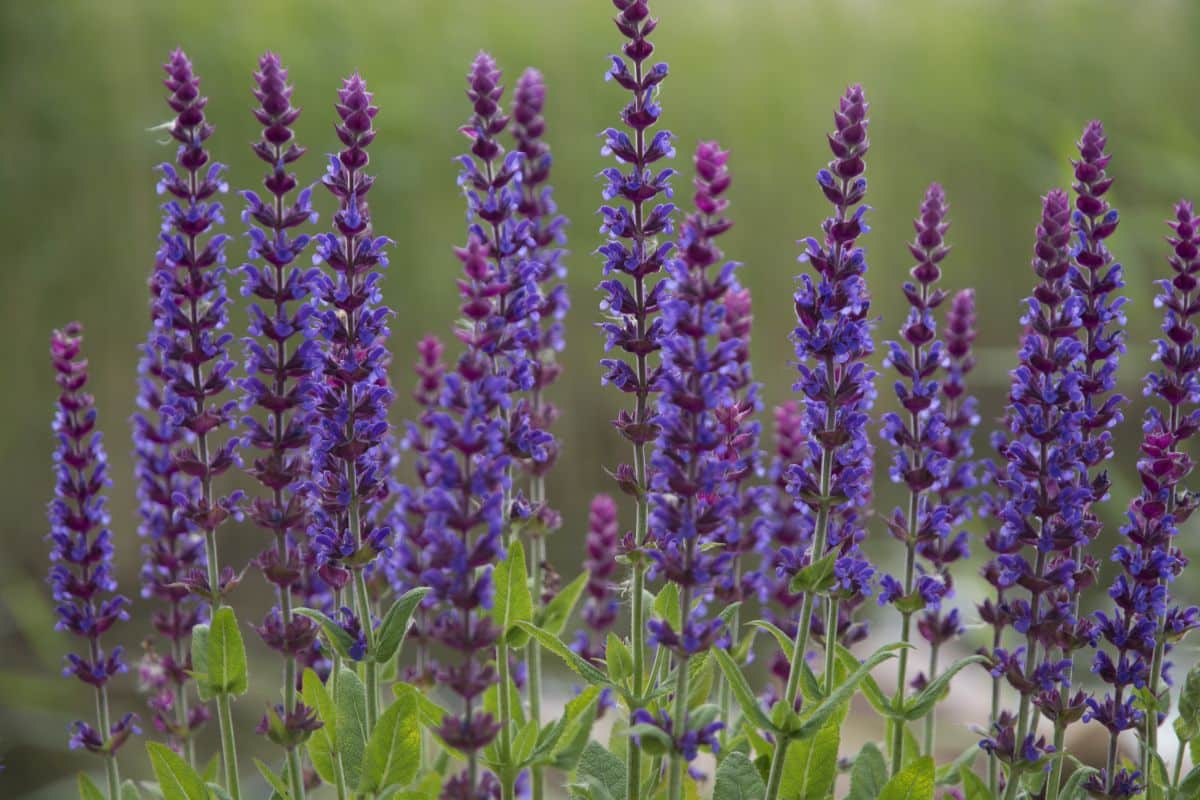
| Plant name: | Salvia |
| Lighting requirements: | Full sun to part shade, depending on variety |
| Watering requirements: | Moderate |
| Growing zone: | Zones 4 to 10, depending on variety |
| Special features: | Pollinator favorite |
Culinary sage is a type of salvia, but there are many other salvias to choose from. In fact, there are at least 900 different types of salvia, including some perennial and annual options. Flower color and shape can vary significantly too, although it’s easiest to find salvias with purple or red flowers.
In the garden, salvias are beginner-friendly plants that can grow just about anywhere roses can. Not only do these plants look pretty together, but salvia is sure to bring bees and butterflies to your garden. Most salvias have fragrant leaves that are good for potpourri making and other crafts too.
20. Larkspur (Delphinium spp.)
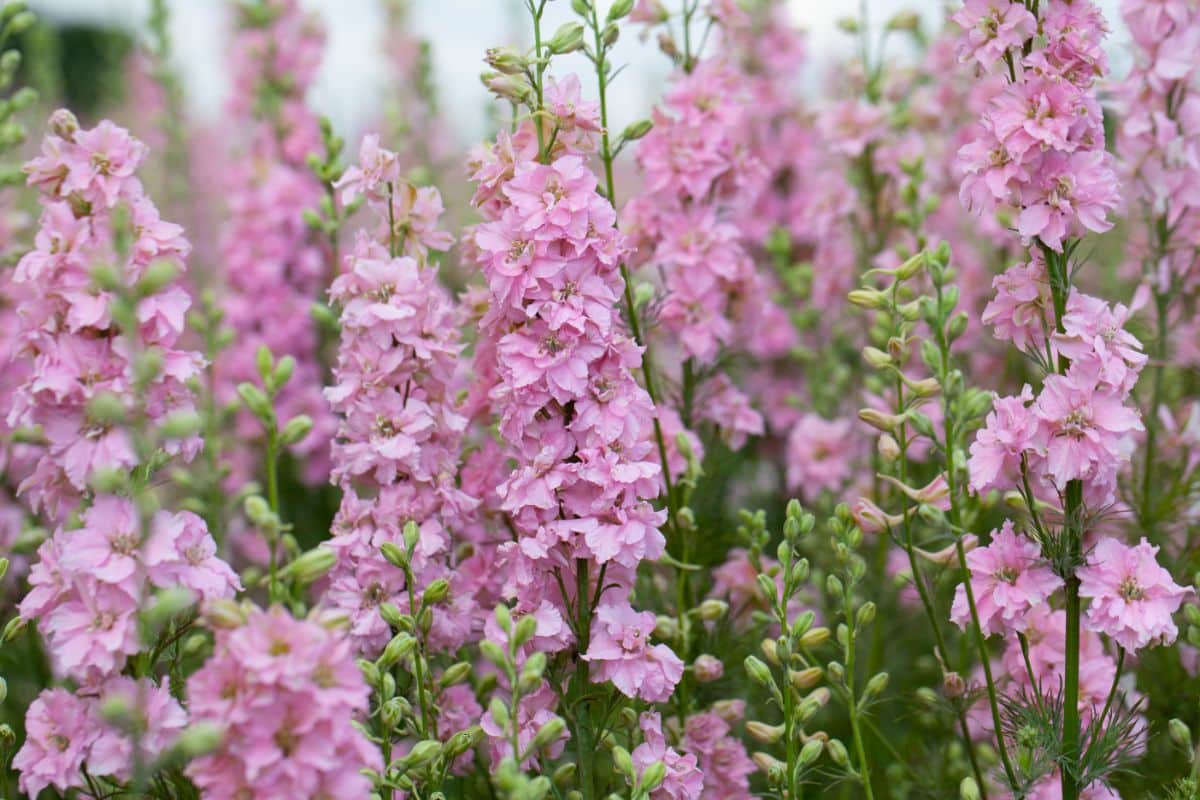
| Plant name: | Larkspur |
| Lighting requirements: | Full sun |
| Watering requirements: | High to moderate |
| Growing zone: | Zones 2 to 11 |
| Special features: | Great for cut flowers |
Larkspur are annual plants that produce tall spikes of flowers in pink, purple, blue, and white. A traditional choice for cottage gardens, larkspur adds height to rose beds, and flowers usually have a longer bloom time than roses. In fact, you may be able to enjoy larkspur blooms from spring to fall.
Larkspur can be purchased as nursery starts, but these plants are easy to grow from seeds too. Seeds can be planted outdoors in spring or autumn, but they do require a period of cold to jumpstart germination. That means that spring-planted larkspur seeds should be cold stratified for 1 to 2 weeks before they’re planted in soil.
21. Germander (Teucrium spp.)
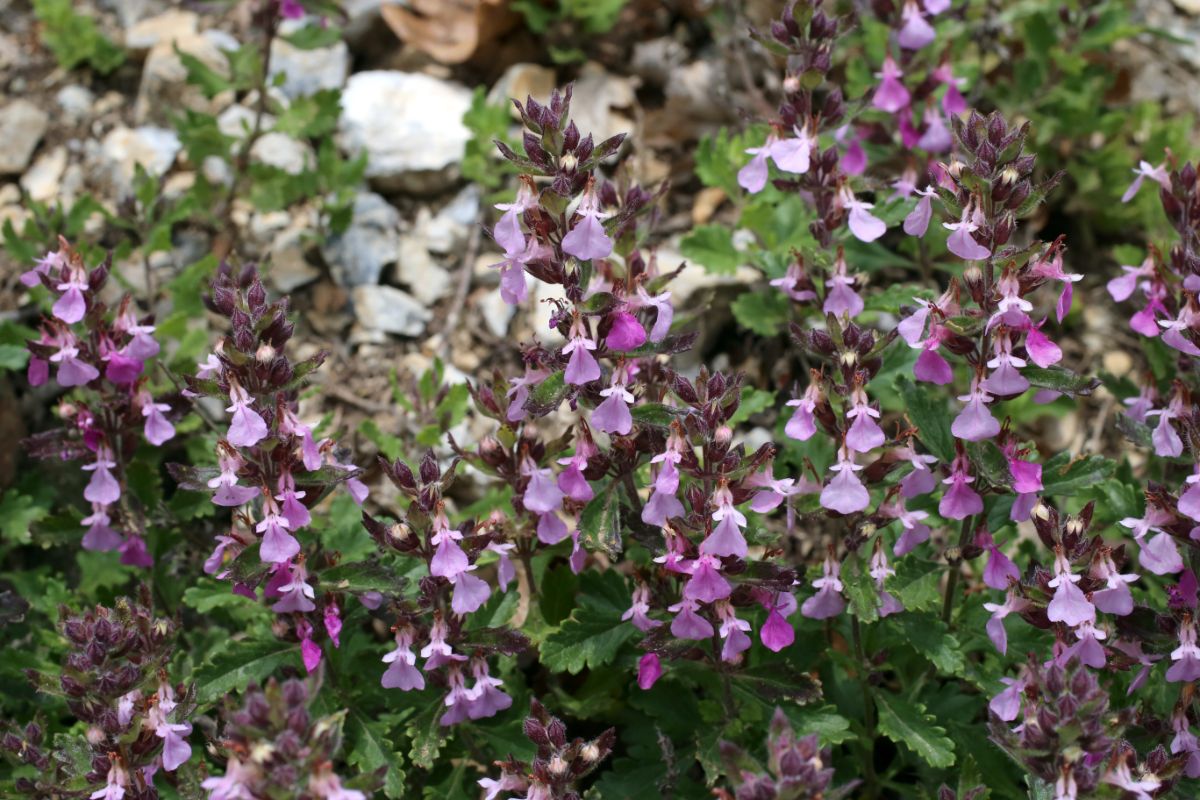
| Plant name: | Germander |
| Lighting requirements: | Full sun |
| Watering requirements: | Moderate |
| Growing zone: | Zones 5 to 10 |
| Special features: | Weed suppression; Great for crafting |
Germander is a less commonly grown plant; however, it was once popular as a medicinal plant. Today, germander is mostly grown as an ornamental, but it can also be used for crafting. When stems are dried, they release a delightful fragrance which makes them a popular ingredient to include in homemade potpourri and wreath-making.
A low-growing plant, germander forms dense mats as it spreads, which can suppress weeds around your rose bushes. Germander also flowers pretty pink blooms early in the season before roses bud out. Once flowers fade, germander plants remain attractive thanks to their richly colored, deep green leaves.
Summary
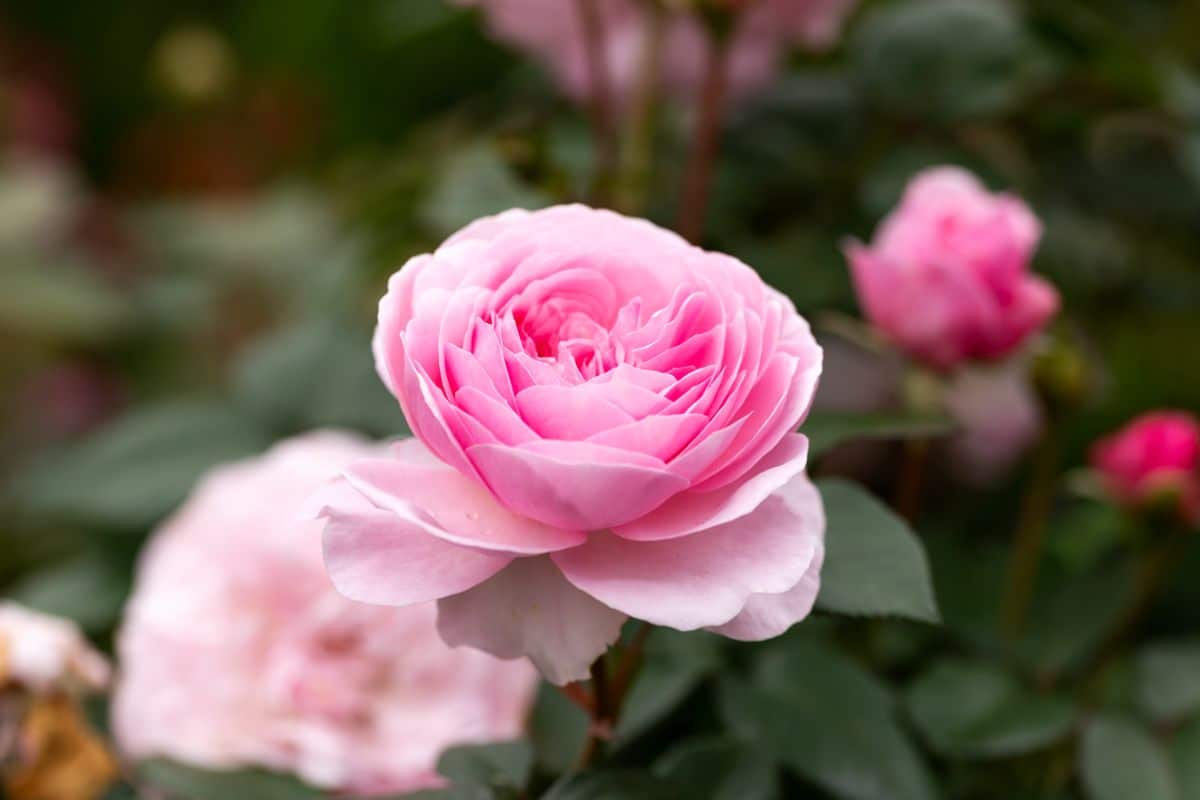
From sawflies to aphids, many pests cause problems for homegrown roses. But if you keep the right companion plants nearby, you can ward against pest predation and keep your roses looking their finest.
Beyond natural pest control, companion plants can also keep weeds down, promote healthier growth and complement the look and feel of your rose garden. So try out a few of the companion plants we’ve covered today and grow an even prettier and more complete bed of roses this gardening season.
If you’d like to learn more about companion planting, check out our guide on the top companion plants for tomatoes.

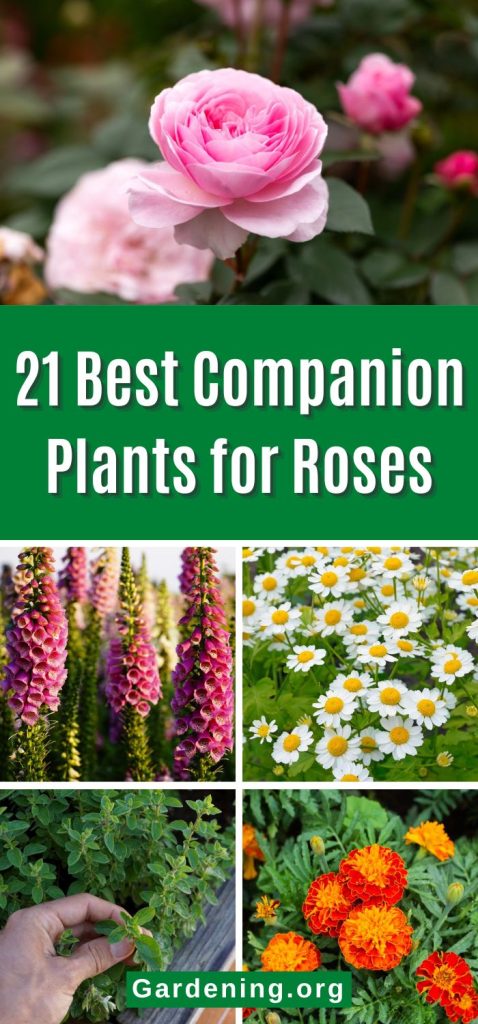
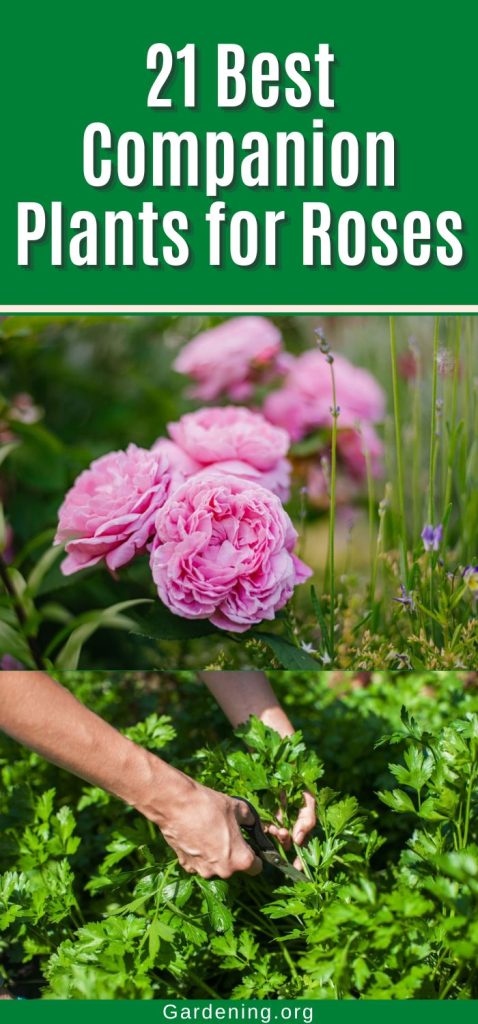
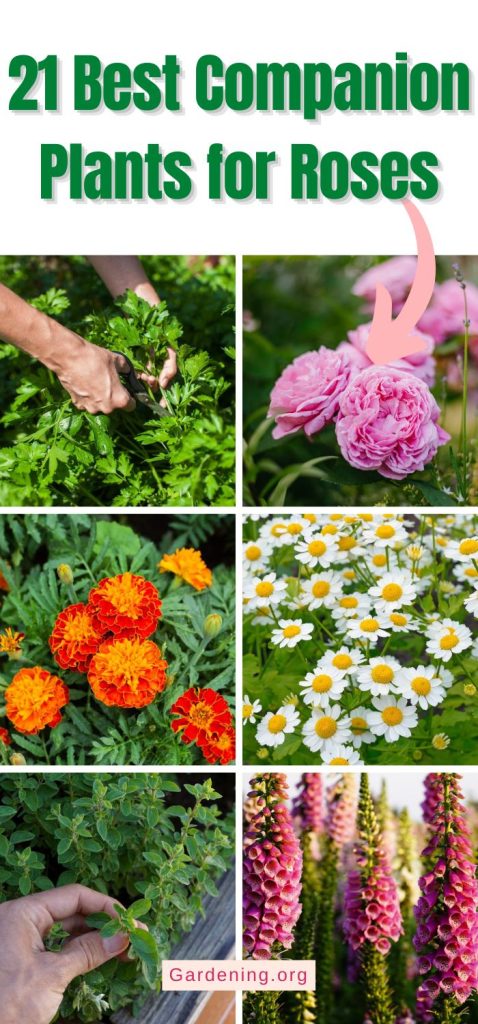


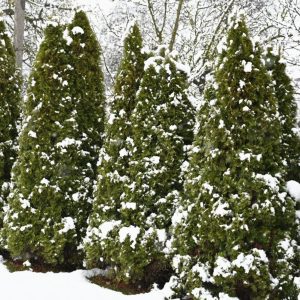


Leave a Reply